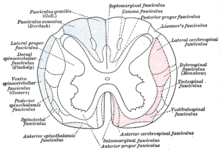| Subacute combined degeneration of spinal cord | |
|---|---|
 | |
| Diagram of the principal fasciculi of the spinal cord. (In subacute combined degeneration of spinal cord, the "combined" refers to the fact that the dorsal columns and lateral corticospinal tracts are both affected, in contrast to tabes dorsalis which is selective for the dorsal columns.) | |
| Specialty | Neurology |
Subacute combined degeneration of spinal cord, also known as myelosis funiculus, or funicular myelosis,[1] also Lichtheim's disease,[2][3] and Putnam-Dana syndrome,[4] refers to degeneration of the posterior and lateral columns of the spinal cord as a result of vitamin B12 deficiency (most common). It may also occur similarly as result of vitamin E deficiency,[5] and copper deficiency.[6] It is usually associated with pernicious anemia.
Signs and symptoms[edit]
The onset is gradual and uniform. The pathological findings of subacute combined degeneration consist of patchy losses of myelin in the dorsal and lateral columns. Patients present with weakness of the legs, arms, and trunk, and tingling and numbness that progressively worsens. Vision changes and change of mental state may also be present. Bilateral spastic paresis may develop and pressure, vibration, and touch sense are diminished. A positive Babinski sign may be seen.[7] Prolonged deficiency of vitamin B12 leads to irreversible nervous system damage. HIV-associated vacuolar myelopathy can present with a similar pattern of dorsal column and corticospinal tract demyelination.[citation needed]
It has been thought that if someone is deficient in vitamin B12 and folic acid, the vitamin B12 deficiency must be treated first. However, the basis for this has been challenged, although due to ethical considerations it is no longer able to be tested if "neuropathy is made more severe as a result of giving folic acid to vitamin B12- deficient individuals".[8] And that if this were the case, then the mechanism remains unclear.[9]
Administration of nitrous oxide anesthesia can precipitate subacute combined degeneration in people with subclinical vitamin B12 deficiency, while chronic nitrous oxide exposure can cause it even in persons with normal B12 levels. Posterior column dysfunction decreases vibratory sensation and proprioception (joint sense). Lateral corticospinal tract dysfunction produces spasticity and dorsal spinocerebellar tract dysfunction causes ataxia.[citation needed]
Cause[edit]
In general, the most common cause of this condition is a deficiency of vitamin B12. This may be due to a dietary deficiency, malabsorption in the terminal ileum, lack of intrinsic factor secreted from gastric parietal cells, or low gastric pH inhibiting attachment of intrinsic factor to ileal receptors.[10] The disease can also be caused by inhalation of nitrous oxide, which inactivates vitamin B12.[11]
Vitamin E deficiency, which is associated with malabsorption disorders such as cystic fibrosis and Bassen-Kornzweig syndrome,[12] can cause a similar presentation due to the degeneration of the dorsal columns.[5]
Diagnosis[edit]
Serum vitamin B12, methylmalonic acid, Schilling test, and a complete blood count, looking for megaloblastic anemia if there is also folic acid deficiency or macrocytic anemia. The Schilling test is no longer available in most areas.[13]
MRI-T2 images may reveal increased signal within the white matter of the spinal cord, predominantly in the posterior columns and possibly in the spinothalamic tracts.[citation needed]
Treatment[edit]
Therapy with vitamin B12 results in partial to full recovery where SACD has been caused by vitamin B12 deficiency, depending on the duration and extent of neurodegeneration.[citation needed]
References[edit]
- ^ Tsoriev A. "Subacute combined degeneration of the cord (funicular myelosis) | Radiology Case | Radiopaedia.org". Radiopaedia. Retrieved 5 February 2022.
- ^ synd/492 at Who Named It?
- ^ L. Lichtheim. Zur Kenntnis der perniciösen Anämie. Verhandlungen des Deutschen Kongress für innere Medizin, 1889, 6: 84-96. 42: 1887.
- ^ Pearce JM (June 2008). "Subacute combined degeneration of the cord: Putnam-Dana syndrome". European Neurology. 60 (1): 53–56. doi:10.1159/000131715. PMID 18520150.
- ^ a b Agamanolis DP (July 2014). "Nutritional CNS Disorders". Retrieved 13 September 2014.
Clinically, vitamin E deficiency causes a sensory peripheral neuropathy, ataxia, retinitis pigmentosa, and skeletal and cardiac myopathy. Neuropathological examination in such cases reveals loss of dorsal ganglionic neurons with degeneration of their peripheral and central axons (peripheral neuropathy and posterior column degeneration respectively). Neuroaxonal swellings are seen in the gracile and cuneate nuclei. Similar changes can be produced in rats and monkeys with experimental vitamin E deprivation.
- ^ Kumar N, Gross JB, Ahlskog JE (July 2004). "Copper deficiency myelopathy produces a clinical picture like subacute combined degeneration". Neurology. 63 (1): 33–39. doi:10.1212/01.WNL.0000132644.52613.FA. PMID 15249607. S2CID 37568461.
- ^ Hemmer B, Glocker FX, Schumacher M, Deuschl G, Lücking CH (December 1998). "Subacute combined degeneration: clinical, electrophysiological, and magnetic resonance imaging findings". Journal of Neurology, Neurosurgery, and Psychiatry. 65 (6): 822–827. doi:10.1136/jnnp.65.6.822. PMC 2170379. PMID 9854956.
- ^ Cuskelly GJ, Mooney KM, Young IS (November 2007). "Folate and vitamin B12: friendly or enemy nutrients for the elderly". The Proceedings of the Nutrition Society. 66 (4): 548–558. doi:10.1017/S0029665107005873. PMID 17961276. S2CID 4639220.
- ^ Boyles AL, Yetley EA, Thayer KA, Coates PM (July 2016). "Safe use of high intakes of folic acid: research challenges and paths forward". Nutrition Reviews. 74 (7): 469–474. doi:10.1093/nutrit/nuw015. PMC 5009460. PMID 27272334.
- ^ Greenburg M (2010). Handbook of Neurosurgery 7th Edition. New York: Thieme Publishers. pp. 1187–1188. ISBN 978-1-60406-326-4.
- ^ Paris, Alvar; et al. (2023-02-22). "Nitrous oxide-induced subacute combined degeneration of the cord: diagnosis and treatment". Practical Neurology: pn–2022–003631. doi:10.1136/pn-2022-003631. ISSN 1474-7758. PMC 10313972.
- ^ Agamanolis DP (July 2014). "Nutritional CNS Disorders". Retrieved 13 September 2014.
Deficiency of the lipid-soluble vitamin E occurs in cases of intestinal malabsorption such as cystic fibrosis, congenital biliary atresia, intestinal resection, and abetalipoproteinemia (Bassen-Kornzweig syndrome).
- ^ Carmel R (November 2007). "The disappearance of cobalamin absorption testing: a critical diagnostic loss". The Journal of Nutrition. 137 (11): 2481–2484. doi:10.1093/jn/137.11.2481. PMID 17951489.